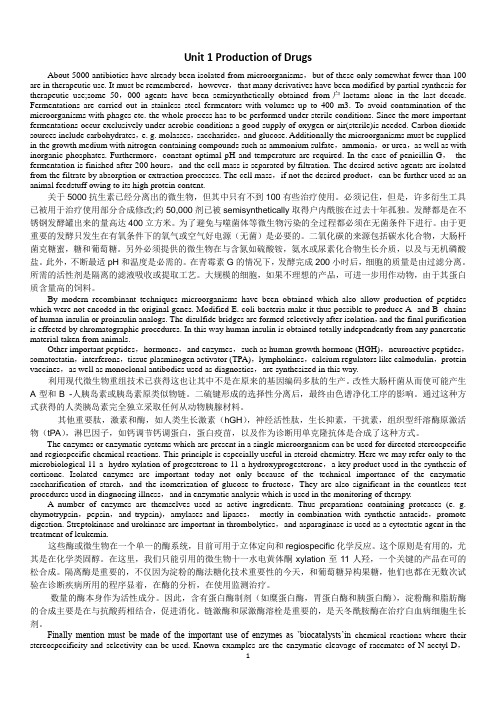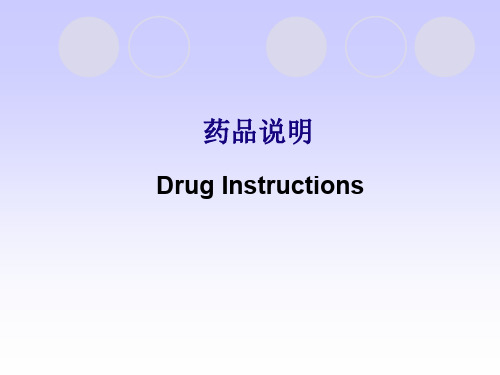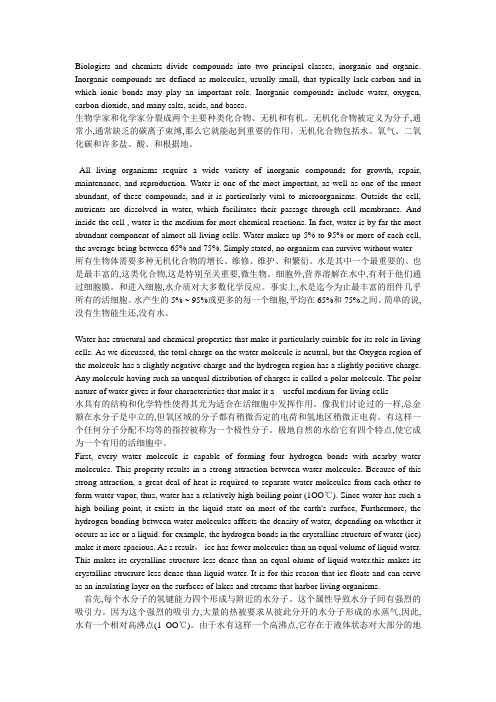制药工程专业英语翻译
制药工程专业英语课文翻译

Unit 1 Production of DrugsAbout 5000 antibiotics have already been isolated from microorganisms,but of these only somewhat fewer than 100 are in therapeutic use. It must be remembered,however,that many derivatives have been modified by partial synthesis for therapeutic use;some 50,000 agents have been semisynthetically obtained from户lactams alone in the last decade. Fermentations are carried out in stainless steel fermentors with volumes up to 400 m3. To avoid contamination of the microorganisms with phages etc. the whole process has to be performed under sterile conditions. Since the more important fermentations occur exclusively under aerobic conditions a good supply of oxygen or air(sterile)is needed. Carbon dioxide sources include carbohydrates,e. g. molasses,saccharides,and glucose. Additionally the microorganisms must be supplied in the growth medium with nitrogen-containing compounds such as ammonium sulfate,ammonia,or urea,as well as with inorganic phosphates. Furthermore,constant optimal pH and temperature are required. In the case of penicillin G,the fermentation is finished after 200 hours,and the cell mass is separated by filtration. The desired active agents are isolated from the filtrate by absorption or extraction processes. The cell mass,if not the desired product,can be further used as an animal feedstuff owing to its high protein content.关于5000抗生素已经分离出的微生物,但其中只有不到100有些治疗使用。
制药工程专业英语 Unit 13 课文翻译

Unit 13 Sterile ProductsSterile ProductsSterile products are dosage forms of therapeutic agents that are free of viable microorganisms. Principally,these include parenteral,ophthalmic,irrigating preparations. Of these, and parenteral products are unique among dosage forms of drugs because they are injected through the skin or mucous membranes into internal body compartment. Thus,because they have circumvented the highly efficient first line of body defense,the skin and mucous membranes,they must be free from microbial contamination and from toxic components as well as possess an exceptionally high level of purity. All components and processes involved in the preparation of these products must be selected and designed to eliminate,as much as possible,contamination of all types,whether of physical,chemical,or microbiologic origin.Preparations for the eye, though not introduced into internal body cavities,are placed in contact with tissues that are very sensitive to contamination. Therefore,similar standards are required for ophthalmic preparations).Irrigating solutions are now also required to meet the same standards as parenteral solutions because during an irrigation procedure,substantial amounts of these solutions can enter the bloodstream directly through open blood vessels of wounds or abraded mucous membranes. Therefore,the characteristics and standards presented in this chapter for the production of large-volume parenteral solutions apply equally to irrigating solutions. Sterile products are most frequently solutions or suspensions,but may even be solid pellets for tissue implantation. The control of a process to minimize contamination for a small quantity of such a product can be achieved with relative ease. As the quantity of product increases,the problems of controlling the process to prevent contamination multiply. Therefore,the preparation of sterile products has become a highly specialized area in pharmaceutical processing. The standards established,the attitude of personnel,and the process control must be of a第13 单元无菌产品无菌产品无菌产品是不含微生物活体的治疗剂剂型,其主要包括非肠道用的、眼用的和冲洗用的制剂。
制药工程专业英语--药品说明

去氧胆酸); 化学名为3a,7p dihydroxy-5p-
Cholanoic acid(3a,7p二羟基5p胆烷 酸)。
药品名称翻译可采用音译、意译、音意合译及谐音译意等方法:
1、音译:按英文药品名歌的读音译成相同或相近的汉语。如: Tamoxitn它莫西芬,Ritalin利他林,Amcacin 阿米卡星。音译较为 方便,但不能表意。
Insert原意为“插入物,插页”。
药品说明书即为附在每种药品包装盒中的一 份用药说明。经过注册的进口药品一般是国家 承认的有效药物,其说明书是指导医生与患者 合理用药的重要依据,具有一定的法律效力。
①药品名称(Drug Names), ②性状(Description), ③药理作用(Pharmacological Actions), ④适应症(Indications), ⑤禁忌症(Contraindications), ⑥用量与用法(Dosage and Administration). ⑦不良反应(Adverse Reactions)。 ⑧注意事项(Precautions), ⑨包装(Package), ⑩贮存(Storage), ⑾其他项目(Others)。
7.Kanendomycin is a very stable antibiotic, and its activity do es not decrease when the powder is placed in an airtight conta iner and kept at room temperatures for more than 2 years. 卡内多霉素是一种很稳定的抗生素,其粉沫置于密封容器中,在室温 下保存二年以上,活性不减。
生物与制药工程专业英语第三单元翻译

Apparatus--A specification for a definite size or type of container or apparatus in a test or assay is given solely as a recommendation, Where volumetric flasks or other exact measuring, weighing, or sorting devices are specified, this or other equipment of at least equivalent accuracy shall be employed. 仪器——为了一个明确的尺寸或规格类型的容器或设备在测验或分析给出了建议,纯粹,在培养皿或其他精确测量体积、计量、或排序装置是在合同中规定的;这个或其他设备至少应当使用等效精度。
Where low-actinic or light-resistant containers are specified, clear containers that have been rendered opague by application of a suitable coating r wrapping may be used. Where an instrument for physical measurement, such as a spectrophotometer, is speci fied in a test or assay by its distinctive name, another instrument of equivalent or greater sensitivity and accuracy may be used. In order to obtain solutions having concentrations that are adaptable to the working range of the instrument being used, solutions of proportionate. ly higher or lower concentrations may be prepared according to the solvents and proportions there of that are specified for the procedurecu .仪器——为了一个明确的尺寸或规格类型的容器或设备在测验或分析给出了建议,纯粹,在培养皿或其他精确测量体积、计量、或排序装置是在合同中规定的;这个或其他设备至少应当使用等效精度。
制药工程专业英语翻译

High-Performance Zeolite NaA Membranes on Polymer-Zeolite Composite Hollow Fiber Supports聚合物—沸石复合中空纤维载体上的高性能NaA型沸石膜NaA型沸石膜具有亲水性,并且在有机溶液除水中表现出高度选择性,特别是在醇类的脱水中,此过程也是生产生物燃料过程中必要和造价昂贵的一步。
沸石膜过去常用晶种法来合成。
在载体上排种被认为是获得高性能沸石膜的一个关键性因素。
许多排种方法曾在报刊上发表过。
然而,对于合成高渗透蒸发性的沸石膜而言,当中没有一个方法是完美的,主要是因为使晶种在载体表面形成一致排布的困难性。
另一方面,虽然沸石膜依附在大直径(12mm)陶瓷管的应用在亚欧地区已经商业化,但是陶瓷管直径大且价格贵,另外膜的通率低。
大直径与低通率结合在一起,就会导致模块尺寸较大。
不久之前,我们曾报导过一个新的排种方法,浸涂——涂抹沉积,这是在陶瓷中空纤维载体中获得高性能NaA型沸石膜的一种非常有效的方法。
这种基于高性能陶瓷中空纤维的沸石膜可预期明显地减小模块尺寸,但是生产陶瓷中空纤维的花费仍在考虑之中,另外,排种过程仍然困难。
这里,我们介绍一个新策略:利用聚合物—沸石复合中空纤维作为载体。
把沸石晶体作为晶种嵌入聚合物中空纤维中供沸石膜生长,同时它们也把沸石膜“锚”在载体上,从而增加沸石膜的附着力。
从而,一个单独且通常很复杂的排种过程就此可以省略了。
一个非常均匀的晶体排布可以很容易获得,因此,高度可再生的沸石膜就可以连续不断地制备了。
复合中空纤维可以很容易生产,通过在中空纤维剂条成型之前把沸石晶体混进复合原料里即可,并且这样可以降低成本。
聚醚砜—沸石复合中空纤维载体是通过把包含NaA型沸石粉末的聚醚砜溶液纺成中空纤维原丝的方法来制备的,根据文献记载,所得产物之后在水中冲洗并在60℃下干燥。
复合中空纤维载体的表面及横截面通过扫描电子显微镜来检查。
制药工程专业英语--1单元

制药工程专业英语--1单元Unit 11.Depending on their production or origin pharmaceutical agents can be splitinto three groups: Totally synthetic material (synthetics) Naturalproducts ,and Product from partial syntheses (semi-synthetic products)依据其生产或来源,药物制剂可以分为三类:I.完全的合成材料(人工合成材料),II.天然产物,和III.源自部分合成的产品(半合成产品)。
2.The emphasis of the present book is on the most important compoundsof groups I and III-thus Drug synthesis.翻译:所以本书的重点是I和III部分的药物合成。
本书的重点是在于Ⅰ和Ⅲ类中最重要的化合物——药物合成。
3.This does not mean, however , that natural products or other agents areless important.然而这并不意味着,天然产物和其他试剂不重要。
4.they can serve as valuable lead structures, and they are frequently needed as starting materials or as intermediates fo r important synthetic products.它们可以作为有价值的先导结构,他们常常作为重要的合成产品的起始原料或中间体产品。
5:Table1gives an overview of the different methods for obtaining pharmaceutical agents.表1列出了获取药物制剂的不同方法的概述。
制药工程专业英语考试题目及答案

专业英语考试内容:单词10分句子翻译24分根据课文回答问题24分英译汉药品说明书21分翻译汉译英摘要21分Unit 11 Tablet (The Pharmaceutical Tablets Dosage Form)药片(医药片剂剂型)Role in TherapyA: The oral route of drug admininistration is the most important method of administering drugs ofr systemic effects.Except in cases of Insulin therapy.the parenteral route is not routinely used for self-administration of medication.The topical route of administration has only recently been employed to deliver drugs to the body for systemic effects,with two classes of marketed products:Nitroglycerin for the treatmint of angina and scopolamine for the treatment of motion sickness.Other drugs are certain to follow,but the topical route of administration is limited in its ability to allow effective drug absorption for systemic drug action.A:口服给药是全身效应用药方法中最为重要的。
除了胰岛素治疗,非肠道药途径不常用在自我服药方面。
制药工程专业英语详细Unit1.3.6详细翻译

Unit 1 Production of Drugs根据其生产或来源不同药物制剂可以分为三类:Ⅰ。
人工合成材料(全合成材料)Ⅱ。
天然产物,和Ⅲ.半合成天然产物(半合成药物).本书的重点是这些第一组和第三组化合物都是合成药物。
然而这并不意味着那些天然药物和其他药物就不重要.他们可以作为很有价值的先导结构,并经常被用为重要合成药物的原料或中间体。
表1概述了获取药物制剂的不同方法。
Table 1 Possibilities for the preparation of drugs表1药物制备的可能性几种最初来自于天然原料有治疗意义天然产物如今用更有效也就是经济的全合成法制备。
这样的例子包括L—氨基酸,氯霉素,咖啡因,多巴胺,肾上腺素,左旋多巴,肽类激素,前列腺素,D —青霉胺,长春蔓胺,以及几乎所有的维生素.在过去的几年里发酵(即微生物处理)变得极其重要。
通过现代技术和遗传选择的结果产生了高效能微生物突变株,发酵已成为广泛的底物(物质)都可以选择的一种方法.真核微生物(酵母菌和霉菌)和原核微生物(单细胞细菌和放线菌)用于微生物。
可以得到以下产品类型:1.细胞原料(单细胞蛋白)2.酶3.主要降解产物(初级代谢物)4.次要降解产物(次级代谢物).除了某些微生物(如肠膜明串珠菌)的黏膜所合成葡萄糖以外第2类和第3类都是与药物的制备相关的物质。
分子量为5万到10万的葡萄糖可以作为血浆替代品。
在这些初级代谢物中谷氨酸棒状杆菌和黄色短杆菌的突变体产生的L —氨基酸是特别有意义的。
利用这些生物体大约可以生产35万吨味精(食物添加剂)和7万吨L —赖氨酸(用于植物蛋白补充)。
更重要的初级代谢产物有嘌。
呤核苷酸,有机酸,乳酸,柠檬酸和维生素,例如谢曼丙酸杆菌产生的维生素12其中首先要提到的次级代谢物是抗生素.以下五类抗生素每年全球销售额170亿美元:青霉素(黄青霉)头孢菌素(假头状孢子头枝顶孢属)四环素(金色链霉菌)红霉素(红霉素链霉菌)氨基糖苷类抗生素(灰色链霉菌)微生物已经分离出大约5000种抗生素的,但其中只有不到100种应用于临床治疗。
制药工程专业英语--11单元

P117--14制药专英作业Unit111.The oral route of drug administration is the most important method of administering drugs for systemic effectsTranslations:口服给药是通过给药途径产生系统效应中最重要的方法。
2.Except in cases of Insulin therapy,the parenteral route is not routinely used for self-administration of medication除了胰岛素疗法之外,肠外给药途径通常不适用于患者自主用药。
3.The topic route of administration has only recently been employed to deliver drugs to the body for systemic effects , with two classes of marketed products : Nitroglycerin for the treatment of angina and scopolamine for the treatment of motion sickness.局部给药这种途径只是近年来才被用于把药物送到人体内从而产生系统效应,采用这种给药方式的药物有两种已经上市:用于治疗心绞痛的硝酸甘油酯和治疗晕动症的莨岩胺。
4.Other drugs are certain to follow , but the topical route of administration is limited in its ability to allow effective drug absorption for systemic drug action.今后肯定还会有其他的药物相继出现,但是局部给药的途径在药物有效吸收从而产生药物系统效应方面仍有其局限性。
制药工程专业英语课文翻译1 5 11 13 16单元原文加翻译

Unit 1 Production of DrugsDepending on their production or origin pharmaceutical agents can be split into three groups:I .Totally synthetic materials (synthetics),Ⅱ.Natural products,andⅢ.Products from partial syntheses (semi-synthetic products).The emphasis of the present book is on the most important compounds of groups I and Ⅲ一thus Drug synthesis. This does not mean,however,that natural products or other agents are less important. They can serve as valuable lead structures,and they are frequently needed as starting materials or as intermediates for important synthetic products.Table 1 gives an overview of the different methods for obtaining pharmaceutical agents.1单元生产的药品其生产或出身不同药剂可以分为三类:1。
完全(合成纤维)合成材料,Ⅱ。
天然产物,和Ⅲ。
产品从(半合成产品)的部分合成。
本书的重点是团体的最重要的化合物Ⅰ和Ⅲ一所以药物合成。
这并不意味着,但是,天然产品或其他代理人并不太重要。
它们可以作为有价值的领导结构,他们常常为原料,或作为重要的合成中间体产品的需要。
生物与制药工程专业英语第二单元翻译

Biologists and chemists divide compounds into two principal classes, inorganic and organic. Inorganic compounds are defined as molecules, usually small, that typically lack carbon and in which ionic bonds may play an important role. Inorganic compounds include water, oxygen, carbon dioxide, and many salts, acids, and bases.生物学家和化学家分裂成两个主要种类化合物、无机和有机。
无机化合物被定义为分子,通常小,通常缺乏的碳离子束缚,那么它就能起到重要的作用。
无机化合物包括水、氧气、二氧化碳和许多盐、酸、和根据地。
All living organisms require a wide variety of inorganic compounds for growth, repair, maintenance, and reproduction. Water is one of the most important, as well as one of the rmost abundant, of these compounds, and it is particularly vital to microorganisms. Outside the cell, nutrients are dissolved in water, which facilitates their passage through cell membranes. And inside the cell , water is the medium for most chemical reactions. In fact, water is by far the most abundant component of almost all living cells. Water makes up 5% to 95% or more of each cell, the average being between 65% and 75%. Simply stated, no organism can survive without water 所有生物体需要多种无机化合物的增长、维修、维护、和繁衍。
合肥工业大学各学院、专业名称及其英文翻译

合肥工业大学各学院、专业名称及其英文翻译仪器科学与光电工程学院 School of Instrument Science and Opto-electronic Engineering1、测控技术与仪器 Measurement & Control Technology and Instrument2、光信息科学与技术 Optic Information Science & Technology机械与汽车工程学院 School of Machinery and Automobile Engineering3、车辆工程 Vehicles Engineering4、工业工程 Industrial Engineering5、工业设计 Industry Design6、过程装备与控制工程 Process Equipment & Control Engineering7、机械设计制造及其自动化 Machine Design & Manufacture & Its Automation8、交通工程 Transportation Engineering9、热能与动力工程 Thermal Energy & Power Engineering材料科学与工程学院 School of Material Science and Engineering10、金属材料工程 Metal Materials Engineering11、材料物理 Materials Physics12、无机非金属材料工程 Inorganic Non-metallic Materials Engineering13、材料成型及控制工程 Material Forming & Control Engineering电气与自动化工程学院 School of Electric Engineering and Automation14、电气工程及其自动化 Electric Engineering and Automation15、生物医学工程 Biomedical Engineering16、自动化 Automation计算机与信息学院 School of Computer and Information17、计算机科学与技术 Computer Science & Technology18、电子信息工程 Electronic Information Engineering19、电子信息科学与技术 Electronic Information Science & Technology20、通信工程 Communications Engineering21、信息安全Information Security化学工程学院 School of Chemical Engineering22、高分子材料与工程 Macromolecule Material and Engineering23、化学工程与工艺 Chemical Engineering and Technics24、制药工程 Pharmacy Engineering25、应用化学 Applied Chemistry土木建筑工程学院 School of Civil Engineering26、给排水工程 Water Supply & Drainage Engineering27、工程力学 Engineering Mechanics28、水利水电工程 Hydraulic and Hydro-Power Engineering29、土木工程 Civil Engineering30、建筑环境与设备工程 Architectural Environment & Equipment Engineering建筑与艺术学院 School of Architecture and Arts31、城市规划 Urban Planning32、建筑学 Architecture33、艺术设计 Artistic Design资源与环境学院 School of Resources and Environment34、地理信息系统 Geographic Information System35、环境工程 Environment Engineering36、勘查技术与工程 Exploration Technology & Engineering37、资源勘查工程 Resources Exploration Engineering理学院 School of Sciences38、电子科学与技术 Electronic Science & Technology39、数学与应用数学 Applied Mathematics40、微电子学 Microelectronics41、信息与计算科学 Science of Information & Computation42、应用物理学 Applied Physics管理学院 School of Management43、电子商务 Electronic Commerce44、会计学 Accounting45、工商管理 Business Management46、劳动与社会保障 Labour and Social Security47、信息管理与信息系统 Information Management & System48、旅游管理 Tourism Management49、市场营销 Marketing人文经济学院 School of Humanities and Economics50、财政学 Finance51、广告学 Advertisement52、国际经济与贸易 International Economy & Trade53、经济学 Economics54、思想政治教育 Education in Ideology and Politics55、英语 English56、法学 Law57、社会工作 Social Work生物与食品工程学院 School of Biotechnology and Food Engineering58、生物工程 Bioengineering59、生物技术 Biotechnology60、食品科学与工程 Food Science and Engineering。
- 1、下载文档前请自行甄别文档内容的完整性,平台不提供额外的编辑、内容补充、找答案等附加服务。
- 2、"仅部分预览"的文档,不可在线预览部分如存在完整性等问题,可反馈申请退款(可完整预览的文档不适用该条件!)。
- 3、如文档侵犯您的权益,请联系客服反馈,我们会尽快为您处理(人工客服工作时间:9:00-18:30)。
Distillation columns are vertical, cylindrical vessels containing devices that provide intimate contacting of the rising vapor with the descending liquid.蒸馏塔是垂直的,可以提供给上升的蒸汽与下降的液体直接接触的圆柱形容器控制设备。
This contacting provides the opportunity for the two streams to achieve some approach to thermodynamic equilibrium.这种接触为两个流体实现热力学平衡提供了机会。
Depending on the type of internal devices used, the contacting may occur in discrete steps, called plates or trays, or in a continuous differential manner on the surface of a packing material.取决于使用的内部设备的类型,能使接触出现分离的叫塔板或者分流塔盘,或者是在一个能连续差分方式的包装材料的表面上。
The fundamental requirement of the column is to provide efficient and economic contacting at a required mass-transfer rate.蒸馏塔的根本要求,是为客户提供高效和经济的同时要与必要的质量传输速率相联系。
Individual column requirements vary from high vacuum to high pressure, from low to high liquid rates, from clean to dirty systems, and so on.个人塔的要求各不相同从高真空至高压力,从低到高的液率,从清洁到不清洁的系统,等等。
As a result, a large variety of internal devices has been developed to fill these needs.因此结果是,大量的各种内部装置已被开发,以填补这些需求。
The column devices discussed herein are used for absorption (qv) and stripping, the gas flowing up the column is primarily a noncondensable phase at column conditions, whereas in distillation the gas phase is a condensable vapor.本文所讨论的精馏塔设备,是用于吸收和汽提,主要讨论的是一种非冷凝的气体在色谱柱中向上流动,而在蒸馏气相中是一个冷凝蒸汽的色谱柱条件。
Plate Columns板柱There are two general types in use: crossflow and counterflow.在使用中,一般有两种类型:横流和逆流。
These names refer to the direction of the liquid flow relative to the rising vapor flow.这些名称是指相对于上升的蒸汽流动的方向。
On the cross-flow plate the liquid flows across the plate and from plate to plate via downcomers.在该横流板上的液体流过板和从板板之间通过降液管。
On the counterflow plate liquid flows downward through the same orifices used by the rising vapor.在逆流板的液体则向下流动,用上升的蒸汽通过相同的小孔。
Crossflow Plates. As indicated in Fig.1, liquid enters a crossflow plate from the bottom of the downcomer of the plate above and flows across the active or bubbling area where it is aerated zone where most of the vapor-liquid mass transfer occurs.横流板。
如图1所示,大部分气带发生气-液传质的地方是液体进入横跨活性或鼓泡上方的板并流入降液管的底部的横流板的时候。
The aerated mixture flows over the exit weir into a downcomer所述充气的混合物则进入降液管流过的出口堰。
A vapor-liquid disengagement takes place in the downcomer and most of the trapped vaporescapes from liquid and flows back to the interplate vapor space.汽-液的分离发生在降液管中的大部分被困的蒸汽从液体中逸出,流回板间的蒸气空间的时候。
The liquid, essentially free of entrapped vapor, leaves the plate by flowing under the downcomer to the inlet side of the next lower plate.基本上不含夹带的蒸汽的液体,通过叶板向下流动从该泄水管的入口侧的流入下一个下层板。
The vapor, disengaging from the aerated mass on the plate, rises to the next plate above.蒸气,从充气质谱盘上分离,上升到上述额下一个板。
The pressure drop incurred by the vapor as it passes through the orifices of the plate is fundamental to plate operation.所产生的压力降是由于蒸汽穿过所述的板这个基本操作。
In most plate designs, the pressure drop prevents the crossflowing liquid from falling through the plate.在大多数板的设计中,该压降防止横流的液体落下通过板。
The pressure drop also results from the energy consumed to disperse the vapor-liquid mixture, e.g., to atomize a portion of the liquid to provide increased interfacial area for mass transfer.该压降也导致消耗分散蒸气-液体混合物的能量。
例如,雾化的一部分液体,提供增加的界面面积使质量转移。
Diameters of commercial crossflow plate columns range from 0.3 to 15 m and plate spacings range from 0.15 to 1.2.商业横流板柱的直径范围从0.3至15m及板间距范围从0.15至1.2。
The total pressure drop per plate is often in the range of 0.25 to 1.6 kPa (2-12 mmHg).每块板的总压降通常是在范围为0.25〜1.6kpa(2-12mmhg).The principal vapor-liquid contacting devices are used in current crossflow plate design: the sieve plate, the valve plate, and the bubble cap plate.最重要的液体接触装置被用在通用的横流式金属板的设计中:筛板、筏板、泡罩板。
These devices provide the needed intimate of vapor and liquid, requisite to maximizing transfer of mass across the interracial boundary.这些装置提供了蒸汽和液体之间必须的关系,所需的最大化的转换块状物在边界界面上。
Sieve Plates.筛板。
The conventional sieve or perforated plate is inexpensive and the simplest of the devices normally used.传统的筛板或者有排孔的板是不贵的且最简单的常被用到的装置The contacting orifices in the conventional sieve plate are holes that measure 1 to 12 mm diameter and exhibit ratios of open area to active area ranging from 1:20 to 1:7.在传统筛板里的接触孔是一些直径在1到12毫米的洞且过流面积面积和有效面积的展览比率从1:20到1:7不等。
If the open area is too small, the pressure drop across the plate is excessive;if the open area is too large, the liquid weeps or dumps through the holes.如果过流面积太小,板的压力下降是过快的;如果过流面积太大了,液体渗出液会从洞里流出。
V alve Plates.筏板。
Valve plates are categorized details of design vary from one vendor to another.筏板是被归为私人拥有的,他的设计细节是多种多样的从一个卖主到另一个卖主。
